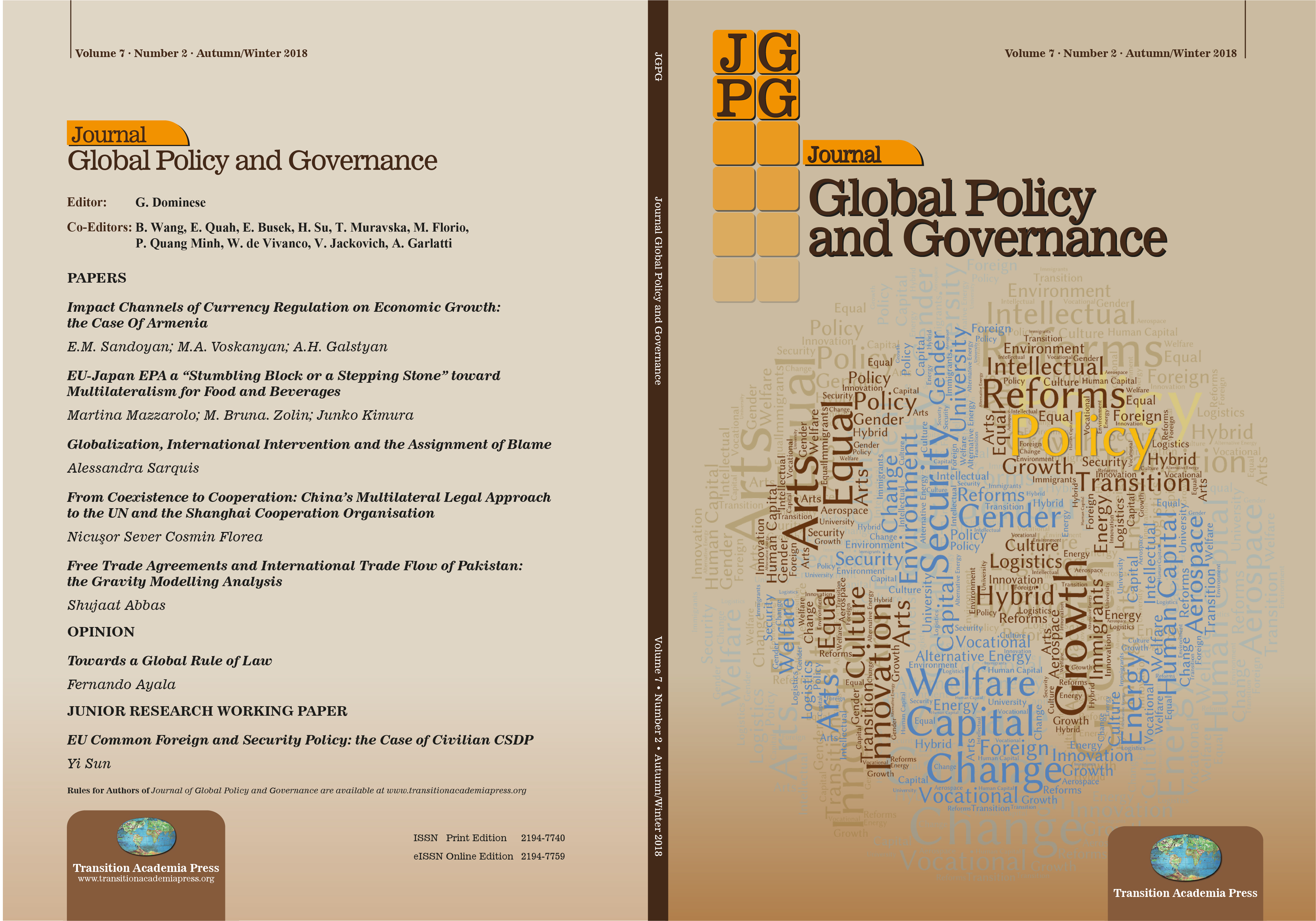Free Trade Agreements and International Trade Flow of Pakistan: the Gravity Modelling Approach
DOI:
https://doi.org/10.14666/2194-7759-7-2-005Keywords:
free trade agreements, export flow, imports flow, economic integration, gravity model, panel dataAbstract
This study explores the effect of regional and bilateral free trade agreements on international trade flow of Pakistan with respects to 47 global trading partners from 1980 to 2016 using log-linear panel generalized ordinary least technique on augmented gravity equations. The result of the standard gravity equation is consistent with the theory of the model. The findings of the augmented gravity models revealed that the SAFTA have a significant negative effect in both export flow and import flow indicating lower trade creation among regional countries. The findings of bilateral free trade agreements with China, Malaysia, and Indonesia revealed a significant positive effect on import flow; whereas, insignificant and/or negative effect is observed in exports flow. The FTA with Sri Lanka and the USA revealed the negative effect on import flow with a positive effect on bilateral export flow. Pakistan should revisit these free trade agreements and renegotiate for corresponding market access.
Downloads
References
Abbas, S. (2016). Remittances Flow to Pakistan: A Gravity Approach, Journal Transition Studies Review, 23(1), 97-106
Abbas, S., & Waheed, A. (2018). Import determinants and Potential Markets: A Panel Data Gravity Modeling Analysis for Bahrain, Review of Middle East Economics and Finance, 14(1), 1-7
Abbas, S., & Waheed, A. (2015). Pakistan’s Potential Export Flow: The Gravity Model Approach. Journal of Developing Areas, 49(4), 367-378.
Alam, M. M., Uddin, M. G., & Ta, K. M. (2009). Import Inflows of Bangladesh: the Gravity Model Approach. International Journal of Economics and Finance, 1(1), 131-140.
Achakzai, J. K. (2006). Intra-ECO Trade: A Potential Region for Pakistan’s Future Trade. The Pakistan Development Review, 45(3), 425–437.
Akther, N., & Ghani, E. (2010). Regional Integration in South Asia: An Analysis of Trade Flows Using the Gravity Model. Pakistan Development Review, 49(2), 105-118.
Anderson, J. (1979). A Theoretical Foundation for the Gravity Equation. The American Economic Review, 69(1), 106-116.
Baltagi, B. H. (2013). Econometric Analysis of Panel Data (5th ed.). Wiley and Sons.
Bergstrand, J. H. (1985). The gravity equation in international trade: Some microeconomic foundations and empirical evidence. Review of Economics and Statistics, 67(3), 474–481.
Bergstrand, J. H. (1989). The generalized gravity equation, monopolistic competition, and the factor-proportions theory in international trade. Review of Economics and Statistics, 71(1), 143–153.
Bergstrand, J. H. (1990). The Heckscher-Ohlin-Samuelson model, the Linder hypothesis, and the determinants of bilateral intra-industry trade. Economic Journal, 100(403), 1216–1229.
Bergeijk, P. A., & Brakman, S. (2010). The Gravity Model in International Trade: Advances and Applications, Cambridge University Press. USA
Batra, A. (2006). India’s Global Trade Potential: The Gravity Model Approach. Global Economic Review, 35 (3), 327-361.
Cinar, E. M., Johnson, J., & Geusz, K. (2016). Estimating Chinese Trade Relationships with the Silk Road Countries. China & World Economy, 24(1), 85–103.
Govt. of Pakistan. (2017). Economic Survey of Pakistan, Ministry of Finance, Islamabad, Pakistan
Gul, N., & Yasin, H. M. (2011). The Trade Potential of Pakistan: An Application of the Gravity Model. The Lahore Journal of Economics, 16(1), 23-62.
IMF (2017). The direction of Trade Statistics, International Monetary Fund, Washington, D.C., USA
IMF (2017). International Financial Statistics, International Monetary Fund, Washington, D.C., USA
Leamer, E. (1974). The commodity composition of international trade in manufactures: An empirical analysis. Oxford Economic Papers, 26(30), 350-374.
Leamer, E., & Stem, R. M. (1970). Quantitative international economics. Boston, MA: Allyn and Bacon.
Linnemann, H. (1966). An Econometric Study of International Trade Flows, Amsterdam: North-Holland.
Malik, S., & Chaudhary, A. R. (2012). The Structure and Behavior of Pakistan’s Imports from Selected Asian Countries: An Application of Gravity Model. Pak. J. Commer. Soc. Sci., 6(1), 53-66.
Magrini, E., Montalbano, P., & Nenci, S. (2017). Are EU trade preferences really effective? An impact evaluation assessment of the Southern Mediterranean Countries’ case. International Review of Applied Economics, 31(1), 126-144
Pastore, F., Ferragina, A. M., & Giovannetti, G. (2009). A Tale of Parallel Integration Processes: A Gravity Analysis of EU Trade with Mediterranean and Central and Eastern European Countries. Review of Middle East Economics and Finance, 5(2), 1475-3693.
Tinbergen, J. (1962). Shaping the World Economy, New York: Twentieth Century Fund
World Bank (2017). World Development Indicators, the World Bank, Washington, D.C., USA
Published
How to Cite
Issue
Section
The authors when submitting their papers endorse and give permission as well to the Publisher Transition Academia Press to publish the article/paper in print and/or electronic format. Article/paper is defined as the final, definitive, and citable Version of Record, and includes the accepted manuscript in its final form, including the abstract, text, bibliography, and all accompanying tables, illustrations, data.
If/when an article is accepted for publication, Author will be asked to transfer copyright of the article to Transition Academia Press. Transition Academia Press will retain copyright of all published material and reserves the right to re-use any such material in any print and/or electronic format. Author willing to retain their copyright from the Editors might request a fair condition, on the base of a bilateral agreement.













